Mere Meheboob Tujeh … A Soulful Melody
By: H.A.K. Walijah
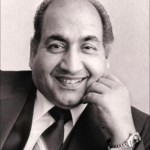
Mohd Rafi
“Mere Mehboob Tujhe Meri Mohabbat Ki Kasam” is a famous and romantic poem of Shakeel Badayuni sung by Rafi Sahab while legendary music director Naushad Saab composed this song based upon Raag Jhinjhoti for the movie “Mere Mehboob” (1963) – a muslim social in the backdrop of nawabi culture. The effect of such slow and romantic song is amazing; magic is in the lyrics plus melody. It was amazing to watch it yet again and enjoy the velvety voice of Mohd. Rafi Sahab. It is one of the most romantic, melodious and all-time-favorite title songs of Mere Mehboob. Rafi Sahab has poured his soul in this amazing extra long six stanza song which has no break at all in the middle and considered till today the best soft romantic songs for the range of voice and its melody of lyrics with music. Almost all music directors used Rafi’s voice to give life and a magical quality to their tunes. Rafi Saab used to build concept about the actors for whom the songs were recorded and went to great lengths to change his style to suit the actor and the scene. This song is an ode of love: emotional, soulful and unequivocal in its nature. The mysticism of poetry is best appreciated and understood when under the influence of the beloved; poetry & music like this confirm that there is beauty and it’s worth living for. This song unlocks the doors behind which the years gone by are preserved, all with their specific feelings and thoughts. It has not aged a single day and shine like new through the cloud that is formed as we journey through life. I really like this song where the actor stands on stage with microphone and sings in front of the audience, it just feels like everyone is there for only one purpose and that is to listen to the song. Naushad Saab once revealed in an interview on All India Radio in late seventies where he admitted that for this particular song he arranged with only five musicians.
The 1960 decade saw many films based on serious romances as well as light hearted romances, in other words we can say this was the Mt. Everest of ‘golden period’ of Hindi Cinema especially in the career of Rafi Sahab who delivered chartbuster songs one after another. The popular songs of Rafi Sahab belongs to this decade where actors like Rajendra Kumar encashed enormous credits by celebrating jubilee after jubilee predominantly on the voice of Mohammad Rafi Sahab played biggest role in it. That doesn’t take away the fact that he was a very good actor. But the songs of his film in Mohammed Rafi’s voice used to become mega hits giving movies a fine opening, and there was a time when every film starring him was a silver jubilee hit. He was considered a golden boy for the movie producers in the sense that he was the actor who could recover the producers’ money in a matter of few weeks. Nothing surprising about them since Rafi Sahab and Rajendra Kumar were inseparable. When Rafi Sahab and Rajendra Kumar combination had such beautiful melodies how come one could forget the song like “Mere Mehboob tujhe meri mohabbat ki kasam”. As a matter of fact this song was nominated for Rafi Sahab as Filmfare Best Male Playback singer award in 1963.
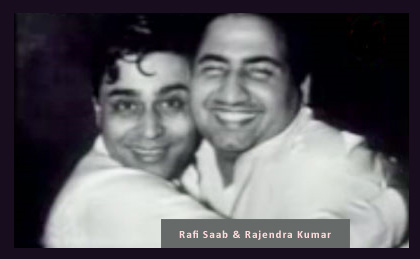
Rajendra Kumar and Mohd Rafi
Mere Mehboob – (1963) starring Rajendra Kumar, Sadhana became a “blockbuster” and took the number one position at the box office in 1963. This was another movie with such amazing songs. I know “Mere mehboob tujhe meri mohabbat ki kasam” is more popular but also the other melodies were breathtaking like – “Tumse izhaar-e-haal kar baithe”, “Ae husn zara jaag tujhe ishq jagaye” and “Yaad main teri jaag jaag ke hum” sounds melodious too. Sadhana looks drop-dead gorgeous…no wonder Rajendra Kumar keeps singing one lovely song after another for her! All these songs are so full of emotions which one can feel as well as see. The success of Mere Mehboob, thanks to Naushad’s innumerable love songs including this hit title song Mere mehboob tujhe meri mohabbat ki kasam and Mere mehboob mein kya nahin, remains unique to the genre. The film immortalized Sadhana’s beauty and grace, elevating her to the status of a minor icon for a while. During the same decade Guru Dutt also attempted a similar Muslim love triangle Chaudhvin Ka Chand with considerable success
Rajendra Kumar was successful to portray the poetic community of Aligarh, Lucknow In the film Mere Mehboob where he formed a new romantic pair with Sadhana and the songs in the film “mere mehboob tujhe meri mohabbat ki kasam” reached the Urdu speaking audience beyond India and far away countries. He did not show any mannerism and sung the song with a microphone at the university hall. In this one, you can see the acting of the actors is so powerful. The expressions on their faces and the emotions their eyes convey are beautiful. Specially instances where Sadhana turns and bows her head during the “maine ek baar teri ek jhalak…” or the tears in both of their eyes at the time of “teri furqat ne pareshaan kiya hai mujhko…” and then later Sadhana wiping her tears. And the pin-drop silence in this big hall full of audience just adds to the seriousness of the romantic song. You will see surely touch a chord with the tunes of soft romantic numbers.
It was the brilliance of H.S.Rawail, the director of this film who created the situation for this immortal song is very much commendable. Anwar, the hero, collides with a burkha-clad girl, Husna, in the college precincts and is instantly smitten though he just sees her eyes (and so is she). To find the girl, he is advised to compose a song to her and sing in the annual college competition. And think this is the outcome of a brief encounter in which they only gaze into each other’s eyes. Actor Danny Denzongpa once described the visage of Sadhana in a burkha with just her eyes visible in Mere Mehboob as “unforgettable.” Sadhana remains the inspiration for most of the bollywood lyricists – as the burkha-clad beauty Husna in Mere Mehboob, she inspired Shakeel Badayuni to compose Mere mehboob tujhe meri mohabbat ki kasam / Phir mujhe nargisi aankhon ka sahara de de. Hasrat Jaipuri showered epithets like Nargis-e-mastaana and Phoolon ki rani, baharon ki malika on her in Arzoo. She became a huge star with the success of Mere Mehboob. I think it was her first Technicolor film where she looked gorgeous and is said to have some of her most beautiful close-ups. It was the worst of times in her life that a lingering thyroid problem aggravated, even affected, those much-admired eyes. At that time she commented, “ I want my fans to remember me as the Sadhana of Love In Simla, Mere Mehboob, Woh Kaun Thi and Arzoo.” when many producers/directors ignored and sidelined her.
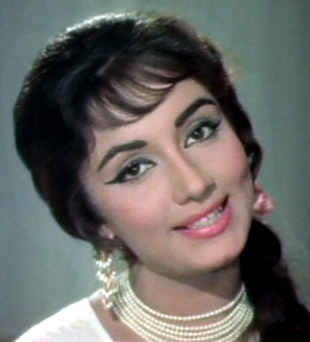
Sadhana
While watching this movie “Mere Mahboob” one could very well experience the richness and multi-layered nuances of Lucknowi Urdu and its power to encapsulate a range of emotions through the songs composed by Naushad Saab who was also a man of great technical knowledge and capable of much innovation. He was the first to introduce sound mixing and the separate recording of voice and music tracks in playback singing, to record separately on a different track and having the music on another track. Naushad was also the first to combine the flute and the clarinet, the sitar and mandolin. He also introduced the accordion to Hindi film music and was among the first to concentrate on background music to extend characters’ moods and dialogues through music. But perhaps Naushad’s greatest contribution was to bring Indian classical music into the film medium and what’s more make them extremely accessible to the layman in films like Baiju Bawra (1952) and Mughal-e-Azam (1960).
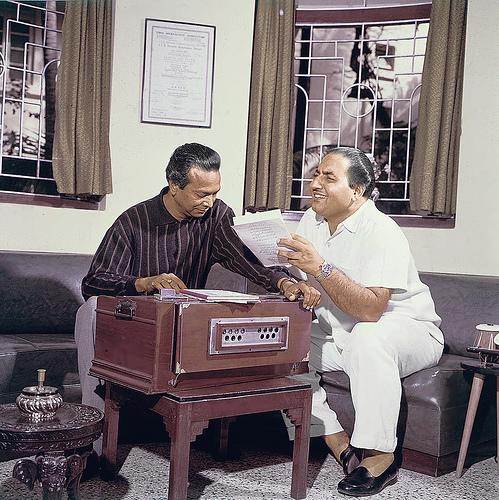
Naushad Sahab and Rafi Sahab
The Rafi-Naushad combination clicked in the 1946 hits, Anmol Ghadi and Jugnu where his duet with Noor Jehan, Yahan badla wafa ka… became the rage. It was Naushad Saab who discovered the singer’s potential for higher notes. Early in his career, in films such as Dillagi, Mela and Anmol Ghadi, Rafi handled a number of popular songs in lower notes. Recollects Naushad, “Rafi saab had tremendous potential for the higher notes too and I used this talent of his in films like Deedar, Amar, Uran Khatola and most important, Baiju Bawara.”
This beautiful Nazm (poem) –“Mere Mehboob Tujhe Meri Mohabbat ki Kasam” enthralled the audience in olden days, it is purely a literary piece delicately chiseled Taj Mahal of enchanting words. It is one of Shakeel Badayuni’s masterpiece poems among hundreds of memorable ghazals & songs. As such one needs to study it and enjoy the beauty of words and feelings. Just close the eyes and listen this song in privacy, I hope, all of you would surely appreciate it.
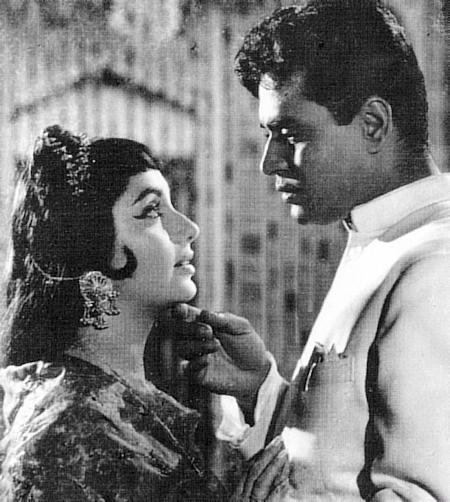
Sadhana and Rajendra Kumar in Mere Meheboob
Have a look at the full version of Nazm (poem/song) in roman Urdu:
Mere mehboob tujhe meri mohabbat ki kasam
Phir mujhe nargisi ankhon ka sahara dede
Mera khoya hua rangeen nazara dede
Mere mehboob tujhe
Ae mere khwab ki taabir meri jaan-e-ghazal
Zindagi meri tujhe yaad kiye jaati hai
Raat din mujhko satata hai tasavvur tera
Dil ki dhadkan tujhe awaaz diye jaati hai
Aa mujhe apni sadaon ka sahara dede
Mera khoya hua rangeen nazzara dede
Mere mehboob tujhe
Bhool sakti nahin ankhen woh suhana manzar
Jab tera husn mere ishq se takraya tha
Aur phir raha mein bikhre the hazaron naghme
Main woh naghme teri awaaz ko de aaya tha
Saaz-e-dil ko unhi geeton ka sahara dede
Mera khoya hua rangeen nazara dede
Mere mehboob tujhe
Yaad hai mujhko meri umr ki pehli woh gadi
Teri ankhon se koi jaam piya tha maine
Mere rug rug mein koi barq si lehrai thi
Jab tere marmari haathon ko chua tha maine
Aa mujhe phir unhi haathon ka sahara dede
Mera khoya hua rangeen nazara dede
Mere mehboob tujhe
Maine ik baar teri ek jhalak dekhi hai
Meri hasrat hai ke mein phir tera deedar karoon
Tere saaye ko samajh kar mein haseen Taj Mahal
Chandni raat me nazaronse tujhe pyar karoon
Apni mehki hui zulfon ka sahara dede
Mera khoya hua rangeen nazara dede
Mere mehboob tujhe
Dhoond tha hoon tujhe har raah mei har mehfil mein
Thak gaye hai meri majboor tamanna ke kadam
Aaj ka din meri umeed ka hai aakhri din
Kal na jaane main kahan aur kahan tu ho sanam
Do ghadi apni nigahon ka sahara dede
Mera khoya hua rangeen nazara dede
Mere mehboob tujhe
Saamne aa ke zara parda utha de rukh se
Ik yahi mera ilaaj-e-ghum-e-tanhai hai
Teri furqat ne pareshaan kiya hai mujhko
Ab to milja ke meri jaan pe ban aayi hai
Dil ko bhooli hui yaadon ka sahara dede
Mera khoya hua rangeen nazara dede
Mere mehboob tujhe
Meri mohabbat ki kasam
Phir mujhe nargisi ankhon ka sahara dede
Mera khoya hua rangeen nazara dede
Mere mehboob tujhe meri mohabbat ki kasam
Mere mehboob tujhe
As I noticed, in the first stanza there are no flashback visuals, but whereas in the second stanza the flashback visuals had been shown as how Anwar collided with Husna and head over heels in love with her by just gazing her eyes under the veil. The rest of stanzas are forwarding steps in emotional sequences. When we come to the final stanza where Husna (Sadhana) turns and bows her head during “maine ek baar teri ek jhalak…” or the tears in both of their eyes at the time of “teri furqat ne pareshaan kiya hai mujhko…” and then later Sadhana wiping her tears is the pinnacle of emotive visuals kept the spectators in spellbound. Mere mehboob tujhe meri mohabbat ki kasam was and still is a more popular track due to its sheer poetical backdrop and Rafi Sahab matchless rendition. The onscreen pair truly lajawaab and the voice very intoxicating. There is no surprise if someone adore Sadhna’s eyes and overall in all her songs. Rajendra Kumar-Sadhna pairing is one of my favourites, especially in Mere Mehboob and Arzoo. Aap Aaye Bahaar Aaye. But I can watch these movies again and again just for the songs in which Rafi Sahab vividly perceptible as musical performer.
Rafi Saab was the voice of film’s story, script and characters. He modulated his voice as per emotion that the song was expected to present in character, story and situation. It was said in the world of Bombay’s film industry that no one had ever heard of a music director saying that a particular song was not Rafi’s type. From classical tunes, gazals, quawalis to the wild ‘yaahoo’ style songs, Rafi’s range was fantastic. Mohammad Rafi, or Rafi sahib as he is always addressed with respect, was not only a great singer, but also a great human being. His versatility was unmatched. He was a master in all types of songs -right from patriotic songs to songs with the sweetness of romance, from songs of utter despair or melancholy to light hearted comedy songs, bhajans, ghazals, qawwalis etc….the list is endless. Can anyone imagine the rendering “Mere Mehboob Tujhe Meri Mohabbat Ki Qasam” or “Ek Hasin Shaam Ko Dil Mera” or “Khoya, Khoya Chaand”? This was Rafi’s range and versatility.
To say something about Rafi’s versatility is just like showing a lamp to the Sun. Who can believe that the man who had sung “Ye mehlon ye takhton ye tajon ki duniya” for the intense Guru Dutt had also sung “Main Jat yamla pagla diwana” for the macho Dharmendra or the man who sang “O duniya ke rakhwale ” for a sober Bharat Bhushan also sang “ Chahe mujhe koi jungle kahe” for the energetic Shammi Kapoor. Teaching a child “ Tu hindu banega na musalman banega, insaan ki aulad hai insaan banega” was as easy for him as romancing a lady with “Teri ankhon ke Siva duniya mein rakha kya hia”. With intensity he hits out at the society with “Jinhe naaz hai Hind par who kahan hai” for the protagonist Guru Dutt in Pyasa and sings a light-hearted “ Sar jo tera chakraye ya dil duba jaye ” for the comedian Johnny Walker in the same film.
For millions of music lovers, the day is not complete without listening to Rafi Sahab songs. During happy moments or sad moments, his voice is always there to give comfort even if we have forgotten him. Any number of adjectives to describe Rafi Saab’s innumerable qualities of head, heart and soul will remain poor and lacking in any writer’s effort. But remembering Rafi Saab in itself is a journey, a never-ending discovery of his rich repertoire. The exercise can be taken up at any time, any number of times.
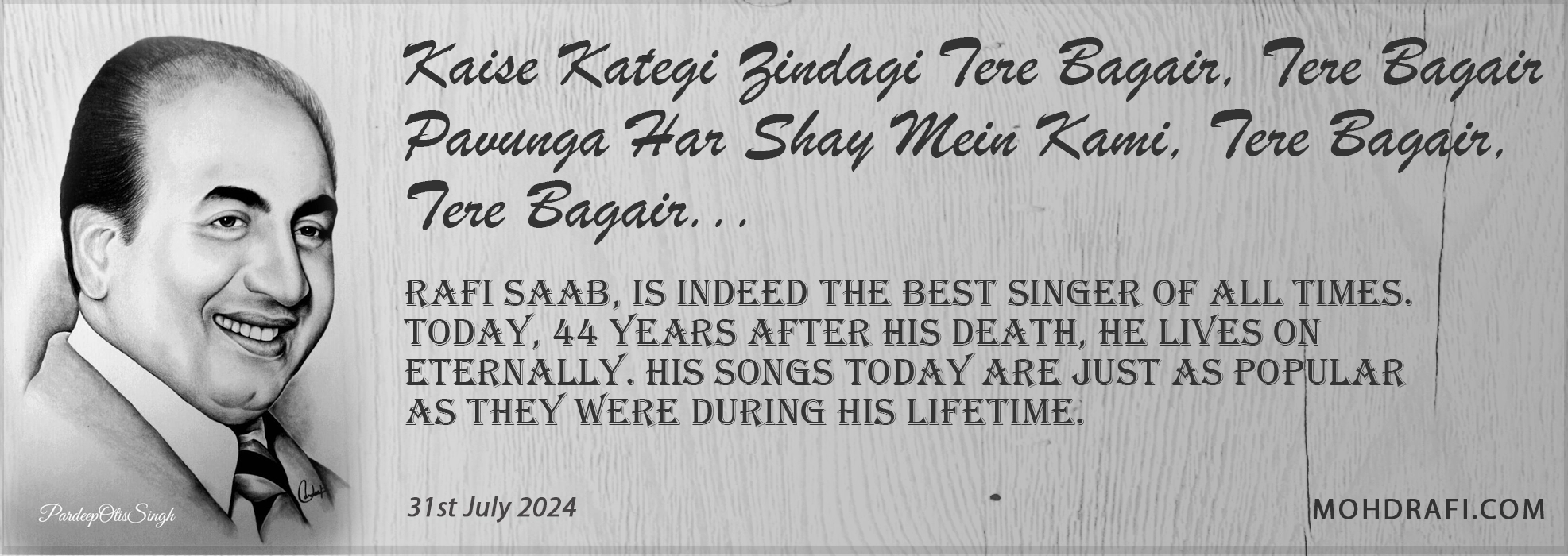
brillient & emotional…one correction the music director of 1946 film jugnu is feroz nizami…not naushad
aap suronke shahanshah hain
aap ruhonke badshah
aap hain aawazke shikhar
Sahir Ludhiyanvi ke nazm ko ruh di Raf Saab ne, Pyaasa ke
Tang aa chuke hain kashmkashe-zindagike hutm
bina kisi saaz, aap nazm pesh kar sakte hain uska misal hai.
Rafi saab to bemisaal hain.
Na awaaz hai aap jaisi kisiki
aapki nazm sunte sunte badi der ho gayi
e badshah-e-mausiki
aaj bandh ankho se jannat ki ser ho gayi…
Dear Anees Saab – post 49, The slight lack in the otherwise fine Walijah Saab’s article has been set right by you. We can appreciate the information on raag better as we have such a fine voice to listen to. It would be great if both of you collaborated to write several articles devoting each to one song and the raag to which Rafi Saab gives voice. It will enhance our knowledge of music – and so entertainingly with Rafi Saab instructing us through his voice.